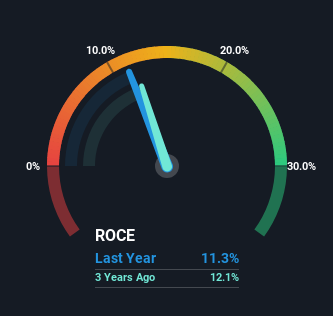- Malaysia
- /
- Consumer Durables
- /
- KLSE:HAILY
Returns On Capital At Haily Group Berhad (KLSE:HAILY) Paint A Concerning Picture
Finding a business that has the potential to grow substantially is not easy, but it is possible if we look at a few key financial metrics. One common approach is to try and find a company with returns on capital employed (ROCE) that are increasing, in conjunction with a growing amount of capital employed. Basically this means that a company has profitable initiatives that it can continue to reinvest in, which is a trait of a compounding machine. Having said that, from a first glance at Haily Group Berhad (KLSE:HAILY) we aren't jumping out of our chairs at how returns are trending, but let's have a deeper look.
Understanding Return On Capital Employed (ROCE)
If you haven't worked with ROCE before, it measures the 'return' (pre-tax profit) a company generates from capital employed in its business. The formula for this calculation on Haily Group Berhad is:
Return on Capital Employed = Earnings Before Interest and Tax (EBIT) ÷ (Total Assets - Current Liabilities)
0.11 = RM13m ÷ (RM232m - RM120m) (Based on the trailing twelve months to December 2024).
Therefore, Haily Group Berhad has an ROCE of 11%. On its own, that's a standard return, however it's much better than the 5.1% generated by the Consumer Durables industry.
See our latest analysis for Haily Group Berhad

While the past is not representative of the future, it can be helpful to know how a company has performed historically, which is why we have this chart above. If you're interested in investigating Haily Group Berhad's past further, check out this free graph covering Haily Group Berhad's past earnings, revenue and cash flow .
How Are Returns Trending?
We weren't thrilled with the trend because Haily Group Berhad's ROCE has reduced by 55% over the last five years, while the business employed 146% more capital. However, some of the increase in capital employed could be attributed to the recent capital raising that's been completed prior to their latest reporting period, so keep that in mind when looking at the ROCE decrease. Haily Group Berhad probably hasn't received a full year of earnings yet from the new funds it raised, so these figures should be taken with a grain of salt.
On a side note, Haily Group Berhad's current liabilities are still rather high at 52% of total assets. This can bring about some risks because the company is basically operating with a rather large reliance on its suppliers or other sorts of short-term creditors. While it's not necessarily a bad thing, it can be beneficial if this ratio is lower.
What We Can Learn From Haily Group Berhad's ROCE
To conclude, we've found that Haily Group Berhad is reinvesting in the business, but returns have been falling. Since the stock has declined 11% over the last three years, investors may not be too optimistic on this trend improving either. All in all, the inherent trends aren't typical of multi-baggers, so if that's what you're after, we think you might have more luck elsewhere.
If you want to know some of the risks facing Haily Group Berhad we've found 4 warning signs (1 shouldn't be ignored!) that you should be aware of before investing here.
While Haily Group Berhad may not currently earn the highest returns, we've compiled a list of companies that currently earn more than 25% return on equity. Check out this free list here.
Valuation is complex, but we're here to simplify it.
Discover if Haily Group Berhad might be undervalued or overvalued with our detailed analysis, featuring fair value estimates, potential risks, dividends, insider trades, and its financial condition.
Access Free AnalysisHave feedback on this article? Concerned about the content? Get in touch with us directly. Alternatively, email editorial-team (at) simplywallst.com.
This article by Simply Wall St is general in nature. We provide commentary based on historical data and analyst forecasts only using an unbiased methodology and our articles are not intended to be financial advice. It does not constitute a recommendation to buy or sell any stock, and does not take account of your objectives, or your financial situation. We aim to bring you long-term focused analysis driven by fundamental data. Note that our analysis may not factor in the latest price-sensitive company announcements or qualitative material. Simply Wall St has no position in any stocks mentioned.
About KLSE:HAILY
Haily Group Berhad
Engages in building construction of residential and non-residential buildings in Malaysia.
Excellent balance sheet with proven track record.
Market Insights
Community Narratives



